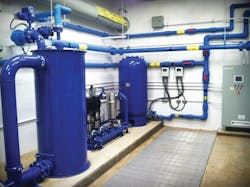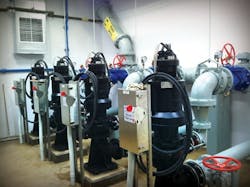About the author: Sara Samovalov is associate editor for W&WD. Samovalov can be reached at [email protected] or 847.954.7966.
The town of Elburn, Ill., (population: 5,700) is notable for being the last stop on the Union Pacific West line of northeast Illinois’ commuter rail system, Metra. Ask Wikipedia about Elburn and you will find little but a mention of a cornfield-dominated landscape. Visit the Elburn Wastewater Treatment Plant (WWTP), however, and you will find quite a lot going on.
A New Era for Elburn
In 1973, the Illinois Environmental Protection Agency (IEPA) placed Elburn on a sewer ban prohibiting further hookups, as its 1955 plant would become overtaxed. With population in the surrounding Fox River Valley area booming, the town embarked on building a new plant—a $3.25 million project mostly funded through a U.S. Environmental Protection Agency (EPA) grant. The new Elburn WWTP was constructed from 1979 to 1980 and began operations on Dec. 23, 1980.
All wastewater is processed at the WWTP; clean water empties into Welch Creek, then Big Rock Creek and eventually into the Fox River. Average flow at the plant in 2015 was .692 mgd.
More than three decades after its 1980 construction, the WWTP sorely needed upgrades to improve employee safety and bring the plant up to IEPA phosphorus standards, which it must meet by 2017. The upgrade process finished in 2016 and was funded through a $9.5 million loan from Illinois’ State Revolving Loan Fund.
A new Parkson mechanically cleaned continuous link 3-mm screen with a Parkson screenings washing screw press replaced the plant’s old manual bar screen. A Smith & Loveless induced vortex grit removal system also was installed—until that point, the WWTP had no grit removal system in place.
Four Flowserve 30-hp submersible pumps re-placed the plant’s existing raw sewage pumps. A Watertronics non-potable water booster pump skid supplies non-potable water for processes in the plant.
The plant upgraded its two Lakeside oxidation ditches to operate as closed loop reactors. Four 5-hp Landia mixers ensure solids are suspended as aerobic and anoxic cycles induce biological phosphorus removal.
To supplement its two 46-ft Lakeside Spiraflo peripheral feed clarifiers, the WWTP added a 65-ft Walker Process clarifier. Wastewater enters a peripheral feed clarifier from the side of the tank and flows around its outer wall until it enters the tank under a skirt that ends around 2 ft above the tank floor. It then rises over effluent weirs. The upgrade process entailed replacing the skirts, bearings, weirs, gear reducers, motors, and paint and scum skimmer arms for both peripheral feed clarifiers. The plant also has begun using sodium aluminate to aid in the clarification process.
A meter/valve vault from EFI Inc. directs the gravity-based flow of sludge into a wet well that was formerly a sludge thickener tank. Atop the tank, three 7.5-hp Smith & Loveless vacuum primed pumps send return activated sludge to the oxidation ditches or to waste.
Waste activated sludge (WAS) is pumped into four aerobic digesters, two of which were added during the upgrades. New Aero-Mod diffusers installed on the tanks aerate the WAS. Three Kaeser 40-hp positive displacement blowers replaced the plant’s original 60-hp blowers. A new Borger 5-hp rotary lobe sludge pump pumps digested sludge to one of seven sand drying beds.
The upgrades included another 21st-century perk: A SCADA system now monitors or controls most processes in the plant, including those in the closed loop reactors and the meter/valve vault for return activated sludge.
Lastly, the upgrades incorporated electrical improvements, including the installation of two new master control centers, variable frequency drives and a mobile generator hookup, as well as LED fixtures to replace fluorescent and incandescent lights in the plant.
Safety First
While the plant upgrades do not increase its capacity, they do make it considerably safer, especially when it comes to “the old and unreliable chlorination and dechlorination systems,” said John Nevenhoven, Elburn’s director of public works.
Now, SCADA proportions chemical feed based on effluent flow. Automatic valve actuators installed on the chlorine cylinders can shut off cylinder valves in the event of a leak. Pulsafeeder wall-mounted pump skids and Pulsatron metering pumps control dosing of sodium aluminate and sodium bisulfite.
The upgrades meant major improvements to the sludge screening process as well—employees once manually cleaned sludge from the pumps, but now the process is controlled electronically.
The plant’s capacity may not be expanding anytime soon, but “the modernization plans included room for additional, future expansions,” Nevenhoven said.
With all major challenges at the plant addressed in the upgrade, the biggest challenges in the future “will be addressing new unfunded, unforeseen regulatory mandates from the U.S. EPA,” he said.


